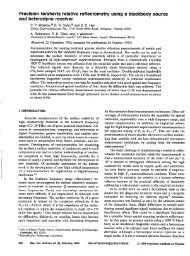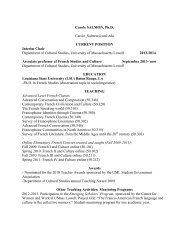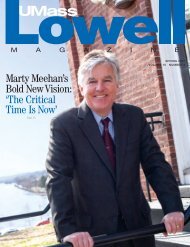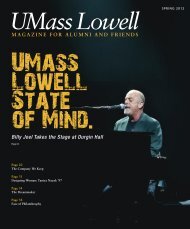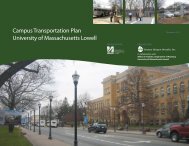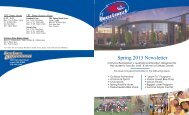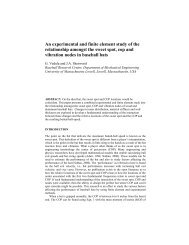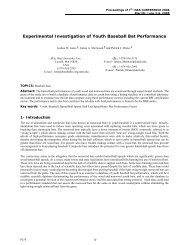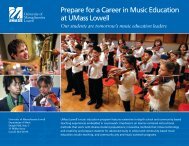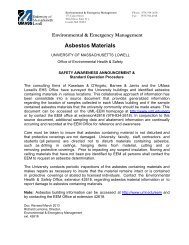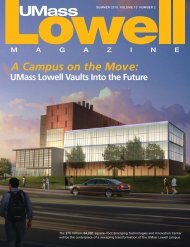Summer 2011 - University of Massachusetts Lowell
Summer 2011 - University of Massachusetts Lowell
Summer 2011 - University of Massachusetts Lowell
Create successful ePaper yourself
Turn your PDF publications into a flip-book with our unique Google optimized e-Paper software.
A L U M N I L I F E<br />
He first saw her in the <strong>Lowell</strong> Tech library,<br />
one day in 1962 or ’63. He was two years<br />
ahead <strong>of</strong> her, a physics major from Methuen;<br />
she was from Pennsylvania, a major in plastics<br />
engineering. She was studying in the balcony,<br />
he remembers — he noticed her right away.<br />
They went out a few times; he asked her to join him on a<br />
ski weekend (he was on the ski team). The first day out,<br />
she broke her ankle. The next day, he broke his. And<br />
that, he says today, “was when the bonding really got<br />
started.”<br />
Paul Katen and Cheryl Vasey were married in 1968,<br />
five years or so after that first library sighting. The path<br />
they’ve traveled since — mostly together, occasionally<br />
apart — has taken them from Florida to Colorado to<br />
California to Oregon (with a two-year side-trip to Australia<br />
by Paul), back to California, and now — finally, since<br />
their retirement 11 years ago — back to Oregon again,<br />
where they both remain very nearly as busy as when they<br />
were pursuing their careers.<br />
These were two careers that involved some pursuing.<br />
Paul, an atmospheric physicist, worked in the early years<br />
for Pratt and Whitney, received a Ph.D. in atmospheric<br />
sciences from Colorado State <strong>University</strong>, then later was<br />
on the faculty at Oregon State <strong>University</strong> (where he did<br />
research on the physics <strong>of</strong> aerosol); then there were the<br />
two years in Canberra, Australia, studying the impact <strong>of</strong><br />
coal-fired power plants, and a later stint as pollution<br />
consultant to the City <strong>of</strong> Los Angeles.<br />
Cheryl’s path, though nearly as peripatetic, is easier to<br />
chart. In 1972, following a year or so with a start-up<br />
whose name she can no longer recall, she went to work<br />
for Hewlett-Packard in Colorado (“I was one <strong>of</strong> the first<br />
women engineers in the business. We were a rare breed<br />
in those days”). Over the next 28 years, as she rose<br />
through the company’s engineering ranks, her responsibilities<br />
widened: from automated tooling <strong>of</strong> HP’s calculators,<br />
to managing its new inkjet project, to running the<br />
project’s R&D side; and finally, to the post from which<br />
she departed in 2000 — general manager <strong>of</strong> the company’s<br />
Home Imaging Division, the branch responsible for production<br />
<strong>of</strong> the company’s photo printers, cameras and<br />
scanners.<br />
“I was in charge <strong>of</strong> a lot <strong>of</strong> very complex projects,” she<br />
says today. “And a big part <strong>of</strong> why I could do that, and<br />
do it well, was my <strong>Lowell</strong> Tech background. It made me a<br />
superb technologist.”<br />
Their careers, though parallel, weren’t always a perfect<br />
fit. Paul moved between jobs; Cheryl’s job moved her<br />
sometimes between cities. But they adapted — and it<br />
kept things interesting, both say. During the time Paul<br />
was posted in Australia, remembers Cheryl: “We would<br />
arrange to meet somewhere every three months. It could<br />
actually be very romantic sometimes.”<br />
Their retirement, from what they tell <strong>of</strong> it, sounds less<br />
like retirement than a series <strong>of</strong> second careers. For Paul,<br />
it has <strong>of</strong>fered the chance to direct his physicist’s skills<br />
toward preservation <strong>of</strong> the Oregon environment. A<br />
defunct amusement park on what was once part <strong>of</strong> an estuary<br />
on the Salmon River, abandoned decades ago, over<br />
the years has crippled an ecosystem crucial to the survival<br />
<strong>of</strong> many species, particularly the river’s salmon.<br />
“This is an important habitat for them,” says Paul,<br />
who now spends his days testing water quality, repairing<br />
fish ladders and removing dams — all part <strong>of</strong> a $1 million<br />
project, led by Salmon Drift Creek Watershed Council,<br />
where he’s been a volunteer for close to 10 years, and the<br />
U.S. Forest Service, to restore the site to its original<br />
state.<br />
“It gives them a place to hide from predators, and<br />
gives them refuge during heavy rains,” so they’re not<br />
swept out to sea before they’re ready. “It hasn’t been<br />
there in forty years. We’re trying to put it back.”<br />
Cheryl’s version <strong>of</strong> retirement has been just as full,<br />
and at least as diverse. During part <strong>of</strong> her week, she<br />
serves as a driver for Meals on Wheels, distributing food<br />
and companionship to seniors along her stretch <strong>of</strong> the<br />
Oregon coast. “It can be very gratifying work,” she says.<br />
Another block <strong>of</strong> time, at least seasonally, is given over<br />
to her work as a tax consultant for AARP — which, as<br />
April 15 approaches, she says, can feel almost like a fulltime<br />
job.<br />
The final piece <strong>of</strong> her working life these days may be<br />
the most fitting. Her job as a volunteer at the local<br />
library, she says, keeps her in touch with an abiding<br />
passion, one that stretches back to her <strong>Lowell</strong> Tech Days<br />
and beyond.<br />
“I love libraries. I always have. I love scanning their<br />
shelves, pulling out books — a book here, a book there<br />
— until you come across one you find absolutely fascinating,<br />
a book you just can’t live without. That’s a wonderful<br />
process. And for all the advantages <strong>of</strong> the digital age —<br />
and there are a lot <strong>of</strong> them, I’ll be among the first to<br />
tell you that — that’s just something that doesn’t happen<br />
with computers.”<br />
It’s a passion that hasn’t stopped with volunteer work.<br />
The Katens’ recent gift to the UMass <strong>Lowell</strong> library fund<br />
— the largest ever, at $230,000, to be divided between<br />
money for technical journals and for a new learning<br />
center — is a clear reflection <strong>of</strong> where their passions lie:<br />
“It was in libraries, probably more than anywhere else,<br />
that I learned how to figure things out for myself,” Cheryl<br />
says. “I always loved studying there. A library is the heart<br />
and soul <strong>of</strong> a university. That’s why we chose the gift<br />
we did.”<br />
What she doesn’t say, but just as well could have, is<br />
that, for a couple whose life together began in the stacks<br />
<strong>of</strong> the LTI library nearly 50 years ago, theirs is also a gift<br />
that brings a marriage full-circle. <br />
“IT WAS IN<br />
LIBRARIES,<br />
PROBABLY MORE<br />
THAN ANYWHERE<br />
ELSE, THAT I<br />
LEARNED HOW<br />
TO FIGURE THINGS<br />
OUT FOR MYSELF.<br />
I ALWAYS LOVED<br />
STUDYING THERE.<br />
A LIBRARY IS THE<br />
HEART AND SOUL<br />
OF A UNIVERSITY.<br />
THAT’S WHY WE<br />
CHOSE THE GIFT<br />
WE DID.”<br />
—CHERYL KATEN<br />
S U M M E R 2 0 1 1 UMASS LOWELL MAGAZINE 33



